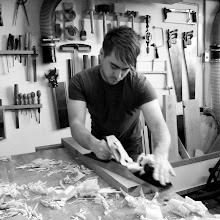
Sometimes the line is the black ink of sharpie, the red grease from a china marker, a scratch mark from an awl, or slice from a sharp knife. Other times, it could be some chalk on a blackboard, some graphite on a napkin, a photograph in your mind, or the distant memory from a dream.
Working to the line takes time, but how long does it take?
Well, at first it may take a long time. Perhaps, such a long time that it might seem like the line is nowhere to be found. More often than not, you’ll miss the line at first, but through practice you’ll learn to find the line. With every iteration, your body and mind will remember the path. Your missteps and your successes will ultimately be the breadcrumbs you leave behind making it increasingly easier to find. Eventually, go forward confidently- Boldly sure of each step, and mindful of the perils that wait on the edge path ahead.
So, does fortune favor the bold or the prepared mind?
Both, together.
I recently had a fairly high-pressure task of engraving some glass vessels with some very precise cuts. The vessels were composed of three layers: the outside was cased in clear, beneath was a thin layer of white and another layer of clear. I had to make mitre cuts through the white layer to create long straight clear lines, all uniform in width. The test piece I had been given to practice on, had a very thick clear layer on the outside, making relatively easy to “sneak” up on the lines I was cutting to. The “real” object, however, had been blown much thinner and the clear outside layer was considerably thinner. I wouldn’t know how much thinner until I made the first cut.
With glass cutting, straightness comes from confidence. The first cuts are made by a course diamond wheel that hogs through the glass allowing you to feed the glass with dynamic and fluid strokes. If you hesitate you will cut too deeply or your line will not be straight. Think of painting with watercolors.
When I made the first cut, I found the outside clear glass to be very thin. In fact, the glass was so thin that I would only be able to make a single roughing pass before I knew I would have gone too far. The heart starts beating harder. I wasn’t afraid however because I was immersed in flow.
(http://en.wikipedia.org/wiki/Flow_%28psychology%29)
Before I made this “first” cut I spent the better part of an hour making test cuts. My hands and eyes were in sync with the spinning wheel in front of me, and I moved the glass around with confidence. In less than 10 minutes, I roughed out the piece. Success! Even though I far from finished (it would take me six more hours to smooth and polish the cuts), I knew I was out of the woods. The rest of the work was slow and careful, but if just one of those first cuts strayed I would have been toast. I was prepared and I was bold.

For the past four year I have been teaching Glass Coldworking at RISD. Every year the first assignment is the same: the flat glass sampler.
The sampler is an assignment that I plagiarized from my first coldworking glass at MassArt. However, unlike the original assignment (which was given over something like 4-5 weeks), my students must complete the task in less than one week. There is nothing creative about the sampler, it is nothing but an exercise in technique. Each student is given a piece of glass roughly 6”x6”. They must dimension the piece to 5”x5” with all four sides square. Two sides must be parallel to one another, one must have a 45 degree bevel, and the last must have a ¼” radius. Finally there must be two equal radiused corners that blend seamlessly from the parallel square edges to the rounded edge. To make things worse, float glass is exceptionally hard and prone to scratching and chipping.
Sound painful?
I guarantee you it is.
I have personally done this assignment myself at least nine times now. Every year, I do the assignment in the morning before the first class and again during demo (in front of a full class). It takes me three hours flat and I still find it challenging. How long does it take someone who has never coldworked glass before?
A lot longer!

So, what’s the point of the “sampler”?
First off, the sampler is designed to use every machine in the shop. So at the end of the week every student has at least attempted to set up and use all of the equipment. Secondly, It teaches basic layout, marking, and process planning. They create reference surfaces and learn to check their work as they go. And finally, and really most importantly, they struggle. Inevitably they make all the classic mistakes and they struggle to correct them. I give them this assignment so they we can target problems and establish good working habits early on. At the end of the week there are very few squares in the class- Many are rectangles or parallelograms and most are way under 5” inches. But everyone learns so much by fighting their way through it. They learn how problems left unaddressed compound themselves many times over. It’s a bit of tough love, but I find it’s better to learn these lessons struggling on a “sampler” than on something that you really care about. Ultimately, the sampler is about creating a line and working to it.





No comments:
Post a Comment